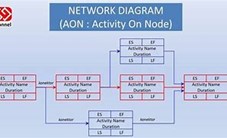CPM is established by using a constructed Precedent Network and is the most dominant scheduling network analysis technique, first developed by the company E I du Pont de Nemours (DuPont) through research in 1956, which led to the influential work of James Kelley and Morgan Walker in 1957, who used the term CPM “because of the central position that critical activities in a project play in the method”.
Another of CPM’s prime success stories is its use in the Apollo 11 Project, which landed two men on the moon on July 20, 1969. NASA used the CPM to help determine an efficient schedule for 2 million tasks that led to the moon landing.
The Apollo project was broken down into 3 phases to simplify the intensity of its planning. The first phase was carried out just to test material safety, quality, and strength, while the deliverable of the second phase was to circle the moon and return. The final phase was when the timing was deemed right to attempt landing Apollo 11.

Precedent Diagram Method

The precedence diagram method (PDM) is a tool for scheduling activities in a project plan. It is a method of constructing a project schedule network diagram that uses boxes, referred to as nodes, to represent activities and connects them with arrows that show the dependencies. It is also called the activity-on-node (AON) method.
• Critical tasks, noncritical tasks, and slack time
• Shows the relationship of the tasks to each other
• Allows for what-if, worst-case, best-case and most likely scenario
Key elements include determining predecessors and defining attributes such as
1. Early start date.
2. Late start date.
3. Early finish date.
4. Late finish date.
5. Duration.
6. Activity name.
Slack/Float: Determines the duration of activity delay that the project can tolerate before the project comes in late. The difference between the earliest and the latest start time. i.e. Slack = last start date - early start day or Slack = last finish time - early finish time.
Any activities which have a zero float, they are on the critical path.
CPM represents the central position that critical activities in a project play in the method."
James Kelley and Morgan Walker